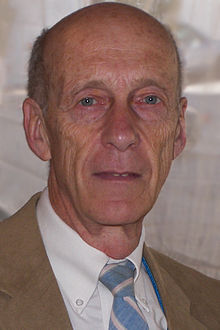Simon LeVay
| Simon LeVay | |
|---|---|

Simon LeVay at the 2010 Texas Book Festival
|
|
| Born |
28 August 1943 Oxford, England |
| Fields | Neuroscience, Neurobiology, Human Sexuality |
| Institutions |
Harvard Medical School Salk Institute University of California, San Diego Stanford University |
| Alma mater |
University of Cambridge (B.A.) University of Göttingen (PhD) |
Simon LeVay (born 28 August 1943) is a British-American neuroscientist. He is renowned for his studies about brain structures and sexual orientation.
LeVay was born on 28 August 1943 in Oxford, England. He is openly gay.
LeVay held positions in neurobiology at the Harvard Medical School from 1974 to 1984. He then worked at the Salk Institute for Biological Studies from 1984 to 1993 while holding an Associate Professorship in Biology at the University of California, San Diego. Much of his early work focused on visual cortex in animals, especially cats. In 2003 he was a lecturer and the Director of Human Sexuality Studies at Stanford University.
In 1991, LeVay published "A difference in hypothalamic structure between heterosexual and homosexual men" in Science. This article reported a difference in average size between the third Nucleus of the Anterior Hypothalamus (INAH3) in the brains of heterosexual men and homosexual men: INAH3 was more than twice as large in heterosexual men as in homosexual men. The INAH3 size of homosexual men was the same as that of women. LeVay wrote that "This finding indicates that INAH is dimorphic with sexual orientation, at least in men, and suggests that sexual orientation has a biological substrate." LeVay added, "The existence of 'exceptions' in the present sample (that is, presumed heterosexual men with small INAH 3 nuclei, and homosexual men with large ones), hints at the possibility that sexual orientation, although an important variable, may not be the sole determinant of INAH 3 size. It is also possible, however, that these exceptions are due to technical shortcomings or to misassignment of subjects to their subject groups."
LeVay's finding was widely reported in the media. LeVay openly related his research to his own homosexuality and to his mourning over his lover's death from AIDS. LeVay cautioned against misinterpreting his findings in a 1994 interview: "It’s important to stress what I didn’t find. I did not prove that homosexuality is genetic, or find a genetic cause for being gay. I didn't show that gay men are born that way, the most common mistake people make in interpreting my work. Nor did I locate a gay center in the brain. The INAH3 is less likely to be the sole gay nucleus of the brain than a part of a chain of nuclei engaged in men and women's sexual behavior." Some critics of LeVay questioned the accuracy and appropriateness of his measurements, observing that the structures are difficult to see in tissue slices and that he measured in volume rather than cell count. Nancy Ordover writes that LeVay has been criticized for "his small sample size and for compiling inadequate sexual histories."
...
Wikipedia
